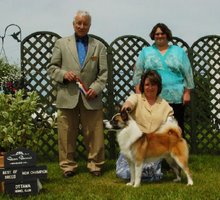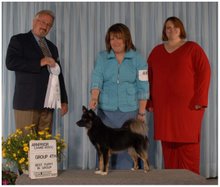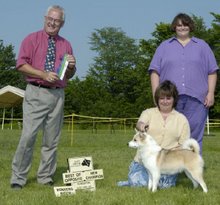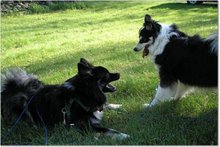More information from Monika in regards to the Peter O study and working with Rare Lines
It was 3700 dogs he started with according to my notes taken at a meeting we had with him in Denmark. I don’t know about the 4 family groups you talk about being the main ones. I think one of his first calculations gave him 5 clusters when doing a 7 generation calculation but he broke them down much smaller when he did the founder dogs and those are the family groups we talk about and have in the database. The ones you mention could be the main groups you have in USA although I do believe you started with a few dogs in the H or J groups as well (this is the Dutch group) and are still working with those groups. Now I really wish I had my computer to check this stuff but I’m using the good old paper copies I have that list all the dogs and their groups up to the year of the study. I have his original work and that’s the one I read along with the conversations I had with him and the info he gave at the first meeting after the study. I just checked the one from the website now and I found out I do have that in a paper copy as well and it does mention all the groups he found so I think the reports I have and the one on the website are pretty similar.
He broke down all the clusters he started with even farther and ended up with the following families that are used to label all the dogs in the database. Every dog belongs to one of these families but unfortunately a newer study is not finished so the dogs born during the years after the study are not labelled. A1, A2, A3, A4, A5, B1, B2, B3, B4, B5, B6, B7, E1, E2, F1, H1, H2, I, J1, J2, J3, K2, K3, K4, M1, M2, M4, M5, O, P, Q, S, U1, V, W. He has the diagrams as well in his work as to which countries each family existed in. I do know however that even though you use a dog in a rarer line the progeny do not necessarily end up being a part of that rare line. So dogs in the A family can be slightly less related to each other (hence A1-A5, five smaller groups inside the large A group) but still stem from the same family so they are not giving us any new genetic material. A1 had dogs in all Scandinavian countries, A2 was mostly Denmark, Finland, Netherlands and Sweden if I’m not mistaken, A3 was only in Denmark and A4 in Germany and Denmark, A5 only in Denmark.
The reason for this being that the dogs that each country brought in and started breeding from in a way started their own families but within the large family group just the same. The same with B, some lines in B are smaller although B3 and B4 can’t really be considered rare (there were still fewer individuals at the time than in the A group). The other main family groups that can’t really be considered rare are H1 and J1 which are found in Holland almost exclusively (up until the past decade). Others are less widespread, all of the B lines were in Iceland with few individuals in Sweden and B5 was only in Germany. And so on and so on. During the years following the study the lines have been interbred to a much larger degree but there are still main family groups in most countries that are being bred more than others.
I do know there were 7 dogs in the 0 line though. A mother and her 6 offspring. There was one single dog belonging to the E1 family and he is gone so that whole "family" has disappeared today. There were also only two dogs belonging to the P family so it was even rarer than the O. Their mother was the only dog belonging to the Q family and she only had two registered puppies, two siblings were the total P family group. One was the grandmother of the O family and the other was her brother who only had ONE single litter in his lifetime and that was with a female in Holland (done by AI) just a couple years ago. His line is EXTREMELY important! I think by doing this combination in Holland that the O line was probably widened rather than lost, maybe even a new family has been made by that combination I really would love to know for sure. But when we view the fact that his sisters offspring were O even though she was used with a dog in the A group then it makes you wonder how a litter out of a smaller family group J1 might be clustered with this P line. So instead of these two siblings making dogs in the P family they started their own family called O. I do believe the idea of this wonderful mating in Holland is to breed these individuals back to the O line that was imported to Holland as well. I think that will be exciting to see a family line arise from that since Holland is the only country now that can breed those two lines together! We don’t even have that line in Iceland anymore.
Now it has to be kept in mind that the rare bloodlines differ greatly in phenotype to the dogs in the larger family groups and so it should be, it means the breed is genetically healthy (alot of variation) to see that we still have so many "posibilities" for differing type as well as colours etc. The problem is that most people don’t recognise the differences in the larger families that they are used to seeing and the smaller rarer lines as a good thing which is sad because they may decide not to use important individuals in breeding just because of slight faults (like HD, less good structure, finer bone or smaller stature). Often people get talked into abandoning their goal of widening the family group because their dogs become "less popular" due to phenotype and possibly people don’t want to buy a dog that can’t "compete" with the rest of the population at shows! They should see and breed the differences with the goal to possibly bring the type closer together (not to breed out the older type but to keep it and improve on faults and vice versa) but keep the genetic variation at the same time. You don’t do that by throwing out the old type and breed solely to a fashion in the show ring in my mind. There are a few very courageous people in our breed and I do salute them for their efforts which they may not see the full results of in their lifetimes. I wish I had the space and time to add more dogs to my home so I too could work on this important project but I use what I have as best I can.
I think possibly it was failed to mention the fact that in order to widen the rarer families we actually have to have higher inbreeding co-efficients in those particular lines to start with. Pieter was very clear on this point in his conversations with me, we need to linebreed them together to increase the population since the numbers of dogs available in those lines is still very limited, it’s almost like starting over again with certain lines. The low inbreeding co-efficients are of course most important in the larger family groups that we have so many more individuals and the population of those dogs are much too similar in their genetics, they have lost variation through stamping of type! I am not an expert on the subject I want to make that clear but I hope I took the right info from my conversations with Pieter when I was thinking of using my own dogs as "gineau pigs" to rarer mates (mine are in the A family group). I did ask if it would be a waste to use my dogs because they were in the bigger family group. What I remember the most is that he felt that the rarer dogs should be used as much as possible so they would need to be bred with many different lines and hopefully more with smaller lines but at the same time since very few are willing to use them then just the fact that they are used was more important than with which line and then they should be bred back to their own line to strengthen their numbers and their genes so that the larger family lines did not double up because then you lose the very genetic material you are trying to save. We can be much more picky with the larger groups whereas the rarer lines need to be used despite faults until the numbers are catching up to the other families.
Skotta the mother is of course dead now and only had that one litter. Of the 6 puppies one is dead (he had been exported to Norway but was never used) that I know of but if they are still alive then 4 remain in Iceland. Two male dogs have been used in Iceland and their one sister was exported to Sweden (I have a grand daughter of hers) and has had a few litters there. I don’t expect to see many more litters from these dogs themselves since they are already 10 years old. Some of their progeny have been exported and very few remain or are being used here in Iceland, I managed to talk the owner into one litter from a 5 1/2 year old daughter to Skolli. I hope she has more litters but I’m not sure she will since the market here is very small and her owner has a busy life and most breeder’s here are not as willing to export puppies out of the country.
I think to a certain degree that it is a bit misunderstood how many litters these rare dogs need to have in order to have enough genetic material that we actually can start to breed smarter with their lines. How else can we widen the gene pool but to use them as much as possible giving them a much larger quota than the dogs in other family lines. However because most breeders will not take a chance on their "type" for the good of the breed’s future it is very sad that we are seeing maybe one or two litters from an O line male and at the same time maybe 10-15 each from other males because they are popular. With this type of thinking the larger families keep getting larger and more threatening, making the rarer lines even smaller all the time even though there may be a few more individuals every year or two the numbers are not growing fast enough in my opinion to keep them from becoming extinct a few years down the road. We have to use some dogs in the larger groups together with these rarer individuals just in order to add to their numbers to be able to go back and linebreed back to them in future. If they are only used with one or two particular families then in future when those are bred back then you are not adding to one particular family but to maybe two at the same time and they get pretty caught up in each other and hard to seperate losing genetic variation from both lines. Does that make sense? I do know of one line here in Iceland for example that was bred to get the M3 line but it is continually bred back to the B3 line to make sure the dogs are "show type" because one particular popular stud was overused and he is hard to avoid now so the M line is being diluted because it can’t be seperated from the B line. So in that sense you need to outcross to be able to break free of the connection between the two lines.
I don’t know I am very concerned about the breed and I know you know that. Hehehe. I for one am concerned about the dilution of all the families constantly and too much mixing, and believe it is causing the popping of hidden diseases and as you say the loss of important breed traits. It is still just a theory that the faults are appearing because of this method of breeding but it started happening at the same time the outcrossing began. I feel the zero co-efficient is causing havock in the breed but my concern is more along the lines of diluting the smaller families into the larger ones because people are too concerned about keeping their type at the cost of keeping breed traits or bloodlines. People may take a chance on breeding a rarer line and then not like what they see and decide to breed back to the larger family in order to get their type back.
This is where I tend to think, and hopefully I don’t sound like I´m contradicting myself from my article and other comments about the breed, that we let dog shows have too much influence on how we breed dogs. NOW let me state that I feel we need to keep the breed type (and there are a few different ones that can still fit into the standard) structure to be able to work and special traits without losing focus on the future of the breed. Structural faults inevitably follow certain lines (and by that it could be bloodlines or family lines, I hope I word that understandably) and in order to fix those faults you need to decide whether the line is from a family group that needs to be widened before it’s fixed or if it´s from a bloodline that has more than enough representatives to keep the structural faulted dogs out of the breeding pool. It makes a big difference and is hard for those who have bred different breeds or other animals to understand that even things like HD in certain important dogs need to be overlooked in order to save the genetics of the line whereas in the larger groups you can afford to be stricter.
It’s good that people all have different opinions and fun to run them past each other from time to time that’s how we can best learn to work together. So I’m gonna go out on a limb here! J I have actually been complaining about how the breed is progressing here in Iceland over the past 3-4 years. I’m extremely worried that we are getting too consistent in type and losing good dogs that don’t fit that mould. Too much stamping of one particular type or consistency can kill off genetic variation very quickly especially when maybe one or two idividuals are used over and over again that all belong to the same family group. We have during the past few years had very few dogs used in breeding, we are losing the old lines and we are also getting more and more competitive people showing the dogs and wanting to win. This means that there are a few old bloodlines left but they are not being shown and not being used much because they are losing their appeal to breeders, the gap is getting larger and larger (the older lines were finer in bone, today you have extreme bone as everyone competes to produce thicker and thicker bone for example and on the other side of the scale some countries don’t have enough bone) too because most Icelanders don’t have a clue about the family groups study and just breed to be able to show so they see these important individuals as "dispensable" and old fashioned. Most if not all the dogs that come to dog shows today are related through two or three overused males, there is no doubt consistency when most the dogs in the ring are very closely related to each other. I for one feel it’s a sad sad time and the more these dogs are bred the smaller the rare family groups get since they cannot compete with the current fashion at shows any more than they could before which originally put them in this position of dying out.
I do agree with you (please excuse my cander everyone) that the "general type" in Iceland differs greatly from that in the US (and I do like the Icelandic type better J ). I feel that is due to the fact that you are breeding different family groups together than we are. For example we don’t have and never have had the J or H family group and we didn’t use the same individual families within the B group that were exported many years ago. Just recently we started using dogs from those family groups and the B3 and B4 have become overused here as well as I’m sure over there. On the other hand what differs from our type and your type is what family groups we are mixing together like I said we haven’t had the other lines that your population is built on. We are using the B and M family much more today but started out with alot of A family dogs. I actually think that the A family is decreasing here (probably other places as well) which also changes the general type and we don’t have dogs that look the same as they used to because of this shifting of popular lines. Sigridur mentioned after the show that she only saw a few of the "old type" which she felt was sad and she thanked the owners and breeders (I was one of them) for keeping those lines going. Linebreeding is taking place big time but in a different way than people expect. You may be breeding a low co-efficient but you are breeding from the same family groups and those dogs could all have similar "faults" and stamp the type they represent in the different "kennels" and family lines and you aren’t really adding genetic variation per se. The fact that the co-efficient is low though means it makes it easier for hidden faults to surface because you are bringing together a lot of lines that were "isolated" within certain kennels. It may be a good idea to add some of the family groups into the US that aren’t already represented in order to be able to bring in different types to "fix" what needs fixing but keep in mind that you will get inconsistency in the first few generations and work with it. These you would work as "rare family groups" in your country even though they may not be rare worldwide, it would give you easy access to dogs that can be used to fix faults and then you can breed back out to those lines you prefer to use. Whereas the rare family groups "worldwide" need a totally different strategy, they need to be bred true after spreading them about. I hope that isn’t too confusing but this is my understanding of what is best for the future of the whole population.
I too would be anxious to know how the pendulum has shifted because it seems to me that some of the family groups have in fact grown much larger while others still remain small and I believe a couple have actually decreased like the A family. Which was of course the thing they set out to do but some families still need alot of numbers to come close to having enough clout to compete in the genepool. The main rare family is still without a doubt the 0 family.
Again I hope my comments aren’t too confusing and I think that what I wrote in my article still holds true and as I say my main concern with the zero inbreeding co-efficient is the hidden defects surfacing out of all the lines and I still stick to that opinion. I know that a bottleneck is not a good thing to have in the breed and unfortunately breeders continue to make bottlenecks all the time by using few studs and popular dogs as "matadors". The fact being that all these matadors are in the same family group (mostly B3 and B4 and possibly J lines today whereas it used to be the A family) makes the situation even more critical for the survival of the rare lines in my opinion.
However as far as I know the A line is not widespread over there, I sent a couple that are half A because I didn’t know of many there at the time. Those individuals are also mixed with the M1, J1 and B3 so it’s a little bit of a puzzle to try to preserve the different lines. Like I said we don’t have data on the family groups for most of the dogs in the breeding program today which makes it hard to assess because it is not easy to figure out who fits in what group by simply looking at their pedigrees when the rarer lines go too far back it’s harder to access them as well since as you mention they can be so diluted by then. You have alot of M line dogs in North America, they make up a large part of your population so it shouldn’t be so hard to mix and match those lines back up but I think the most widespread are the B3 and B4 lines and J1. I can’t wait to get my database working again!
I think that is way too much but I got carried away...I have a habit of doing that! So sorry to those who were bored by the length of it.
Monika
http://www.tofradogs.com/













